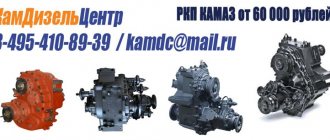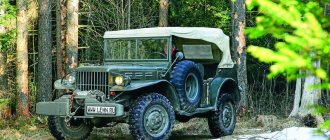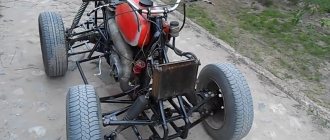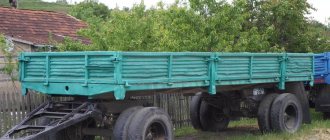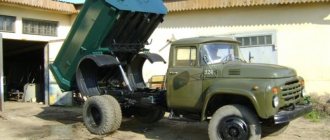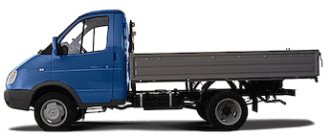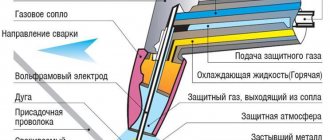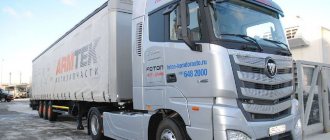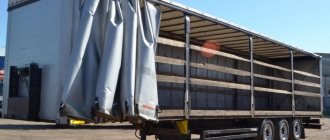The ZIL-157 can now be seen more in movies than on the roads of the country, although the car has become not only a source of pride for the Likhachev plant, but also for the entire Soviet automobile industry. The history of its creation began in 1954, when the Stalin plant began developing a 3-axle all-wheel drive truck for army needs.
The army needed powerful and reliable technology. The ZIS-151, which appeared in the post-war years, could no longer cope with the tasks, but was taken as the basis for the creation of a new Soviet truck. The new ZIL was put into mass production already in 1958. The car was perfect for the 60s. This was recognized in the world (Grand Prix at an international exhibition) and in the Soviet Union (it was used not only in the army, but also in the national economy).
About the history of the car, its predecessor and successor
This off-road conqueror was in serial production for 33 years, from 1958 to 1991. (since 1978 it was no longer produced by the Moscow Likhachev Plant, but by the Novouralsk Automotive Plant). In total, nearly eight hundred thousand of these vehicles were produced, and the last ZIL-157KD rolled off the assembly line in a completely different country - in 1994.
The origin of the 157th ZIL was purely army. As you know, in the first years of the Great Patriotic War, our armed forces experienced an acute shortage of heavy-duty and cross-country trucks. Subsequently, this deficit was eliminated by purchasing and leasing more than one hundred thousand Studebaker cars from the United States. The vast majority of them, those that remained in technically sound condition, were returned to the United States.
After the war, the question arose about establishing our own production of a powerful truck capable of coping with any off-road conditions. At first, purely for military needs, and in the future – for the national economy.
The first copies, prototypes of this model, trucks with three single-slope axles, were produced at the Stalin plant (as ZIL was then called) already in 1946. However, the victory was then won by the idea of developing a truck based on American and captured German technologies, still taking as the main model the same Studebaker, developed in the 30s. This decision was wrong and set our designers back at least ten years.
The result of this policy was the launch of the ZIS-151 model, which in terms of power, speed, and cross-country ability remained at the level of pre-war trucks. The heavy ZIS-151, with twin wheels on the rear axles, with engines of 90, 92 and 95 horsepower, “ate” more than fifty liters of gasoline for every hundred kilometers and chronically suffered from periodic engine overheating. At the same time, during direct operation, it showed clearly insufficient traction performance if it was necessary to carry a large load and, especially, if to tow a loaded trailer.
The predecessor of the 157th is the ZIS-151 truck
The Soviet Army confidently moved forward in its development, and this truck no longer met its increased needs. Therefore, in the fifties, our own, so to speak, innovative idea ultimately prevailed. The novelty was, first of all, in the use of all bridges with the same track and single wheels. This significantly increased the vehicle's maneuverability, while simultaneously reducing mechanical losses.
In many ways, the ZIL-157 was built on the basis of the ZIS-151 (even the cabin was the same), but it was a completely different car. It was launched into production in 1958. And, characteristically, he almost immediately set out to conquer not only ours, but also foreign off-roads: after participating in the Brussels Exhibition of New Automotive Equipment, contracts were signed for the supply of new design trucks to a number of European countries. It sounds unusual, but it is true. In those years, the Soviet Union was not a technologically backward country.
ZIL-157 in Germany. Photos from the 2000s!
From 1958 to 1978, the ZIL-157 was produced at the Likhachev Plant in Moscow. Subsequently, in addition to it, and then to replace it, ZIL-131 and Ural-375 came as newer trucks for the army. Production of the modernized ZIL-157 (with the KD index) was moved to Novouralsk, where it rolled off the assembly line until the 90s of the twentieth century.
Technical characteristics of ZIL-157
What else, besides the use of a system of three axles with the same track on all and single wheels, are the technical features of the design of the ZIL-157 truck?
Frame Features
Unlike many other vehicles of this class, this truck was equipped with a different, rather flat frame. Thanks to it, in conditions of severe off-road conditions, virgin snow or difficult terrain, it did not lose the ability to push off the ground with its wheels, did not get stuck in the mud, sand or snowdrift and could calmly continue its movement.
Features of tires and wheels
Already at the development stage of this model, specialists in the Soviet tire industry were required to develop qualitatively new off-road tires. The point is that these tires allow the car to move confidently even at low internal pressure.
The task was completed: a truck tire was invented, tested and introduced, which had increased elasticity, achieved by reducing the number of cord layers, increasing the profile width and using additional inner layers of soft rubber.
The wheels of the ZIL-157 became wider, they were equipped with a special deep tread - a directional herringbone - that practically eliminates the manifestations of slipping. Because they had the properties of self-cleaning from adhering dirt.
For the first time in the Soviet automobile industry, a system for inflating and adjusting tire pressure was installed on a production vehicle. It was possible to control it without leaving the driver's seat and without stopping the movement of the car. Already in 1961, the inflation system moved from the outer to the inner side of the wheels.
As a result, small punctures and holes in the wheels do not affect the speed of the car; the required amount of air is pumped into the tire by a compressor, and the lack of pressure is compensated. You can continue to drive the ZIL-157 even with a significantly damaged individual tire, compensating for the loss of pressure in it by continuous inflation.
If necessary, while driving on difficult virgin snow, shifting sands, or in marshy areas, it is possible to reduce the tire pressure to 0.7 atmospheres. At the same time, the wheels settle and their surface becomes wider. After passing a difficult section of the route, the tire pressure can be quickly pumped up to normal 2.8 atmospheres.
In general, a maximum pressure of 2.8 kg/cm2 was recommended when driving on paved roads at speeds up to 60 km/h. When driving on rough terrain with difficult soil, it is recommended to reduce the tire pressure to two kg/cm2, and on sand and on soil soggy from rain - to 1 kg/cm2, moving at a speed of 20 km/h. A speed limit of 10 km/h and a pressure reduction to 0.5/0.7 kg/cm2 were recommended for driving through swampy and snow-covered areas. Reducing ground pressure gives a noticeable additional increase in the off-road qualities of the car.
Features of the body and cargo platform
The most widely used is the classic flatbed version of the ZIL-157 with a platform for transporting goods and people, equipped with wooden sides with an opening tailgate. The sides are assembled from 800x200 boards and secured with brackets to a wooden platform, which greatly facilitates the overall structure.
The truck body itself is a platform made of the same wood, covered with longitudinal metal ribs that protect it from abrasion. To ensure the strength of the longitudinal structure, it is reinforced with transverse bars with metal brackets. Only the front side is stationary, while the side and rear sides are folding, capable of completely opening the body platform.
Thus, the process of loading and unloading any cargo and property can be done as simply and quickly as possible. Unlike other trucks of that time, for example, from a similar class GAZ-63.
Engine ZIL-157
In the process of developing the engine for the 157th ZIL, we took into account the “chronic problems” identified during the operation of ZIS-151 trucks: lack of power and reliability, ease of overheating and high gasoline consumption, problems with towing trailers, etc. The ZIL-157 truck received a significantly improved engine, which it was equipped with for twenty years (having been modified in 1961), until its modernization in 1978.
Both the main and modernized ZIL-157 engines are gasoline carburetor engines. During the years of development and production of this off-road conqueror, there were no developed, large-scale industrial technologies for equipping serial trucks with diesel engines. Both here in the USSR (YAZ-214) and abroad, only the first steps were taken in this promising direction, and all production trucks still had gasoline engines.
True, quite successful experiments were carried out on installing diesel engines of the D245-12S brand on the ZIL-157. To do this, it was necessary to cut off the standard supports and weld on brackets from ZIL-130 or ZIL-131.
All fastenings for connecting the engine and gearbox can be easily and simply adapted. However, there is a downside to such modernization: the operation of a diesel engine significantly increases the shaking and vibration levels, which add discomfort to the already rather brutal working conditions of the driver of the car.
Characteristics of the ZIL-157 engine
- Type: gasoline, carburetor, four-stroke, in-line cylinders;
- Cylinder block: cast iron; with a closed “jacket”, along the contour of which coolant circulates;
- Cylinder head: aluminum;
- Number of cylinders: six;
- Volume: 5.559 liters;
- Power: 104 horsepower – before, 110 horsepower – after modernization, at 2600 rpm;
- Torque 334 N/m;
- Sequence of cylinder movement: 1/5/3/6/2/4;
- Cylinder diameter: 101.6 mm;
- Piston diameter: 100 mm;
- Piston stroke: 114.3 mm;
- Valve location: bottom.
The ZIL-157 engine ran on A-66 gasoline, and after modernization in 1978, on 72-grade gasoline (66 probably didn’t exist at that time). Real fuel consumption averages 42 liters of gasoline per 100 kilometers (with uniform driving at a “cruising” speed for this truck of 40 km/h - about 38 liters).
The filling tank on the ZIL-157 holds 150 liters of fuel. After modernization, they began to install another additional tank for 65 liters of gasoline as standard. Thus, the range of the ZIL-157 on one full refueling exceeds 500 kilometers.
The ZIL-157 engine is distinguished by its simplicity of design, reliability, unpretentiousness, and trouble-free operation. It starts easily even after a long period of inactivity or storage in a hangar. However, in the cold season (at constant temperatures below 10 degrees below zero) it still requires special care.
In particular, in protecting and insulating the engine compartment with special insulating casings. (They were included with the car). Because the engine cooling system was unable to maintain the required temperature in severe frosts. Subsequently, this problem was resolved: the thermostat was modified, but the trucks continued to be equipped with insulating casings.
Modified version of the ZIL-157 engine
In general, the new, modified version of the engine, which was equipped with the ZIL-157KD trucks produced since 1978, was largely unified with the engine of the absolute “bestseller” of the Likhachev Automobile Plant - the ZIL-130. The piston group - namely: cylinder liners, pistons, a set of compression rings, connecting rod pins - became completely identical to the engine of the 130th ZIL. The compression ratio was increased from 6.2 to 6.5.
The lubrication system of the improved engine was radically changed; the oil was now cleaned more efficiently in a new type of filter. The lubrication system has been improved by introducing a new oil pump and newly designed crankshaft seals.
The power of the water pump was significantly increased, and a completely new alternator was installed: a small-sized and efficient unit.
The standard starter gave way to a more powerful and reliable one. The conventional distributor gave way to a contact-transistor ignition system. The seals in the water pump were changed and a closed-cycle crankcase ventilation scheme was installed, and the power unit was installed on a new suspension.
Changes were made to the engine cooling system: it had a new radiator, a tubular design, equipped with vertical louvres, through which the air was driven by a powerful six-bladed fan. Thus, the problem of overheating was solved.
Transmission
The ZIL-157, like its predecessor ZIS-151, has a complex transmission with 5 driveshafts: intermediate (between the transfer case and gearbox); to the front axle; to the middle bridge; Two driveshafts are connected to the rear axle, with an intermediate bearing unit on the middle axle.
ZIL-157 trucks were originally equipped with a five-speed gearbox, in which the 5th gear was an overdrive. However, after the modernization of 1961, it was removed. The transfer case taken as a basis from the ZIS-151 acquired wear-resistant gears and new oil seals.
The cardan drive was completely redesigned, and an intermediate support for the rear axle cardan was attached to the middle axle. The axle housings of the drive axles were significantly strengthened, and new wheel hubs and brakes were installed.
The gearbox has synchronizers in 2nd, 3rd, 4th and 5th gears. The transfer case was created according to a two-shaft design. The main gear is characterized as single-stage and has spiral teeth.
Video
The model inherited from the ZIS-151 a complex transmission, supplemented by cardan shafts:
- to medium;
- intermediate;
- rear (two) and front axles.
ZIL-157 was equipped with larger wheels. This model was the first to use a centralized tire pressure control system. Thanks to this, the driver could control the tire pressure (by choice or all at once) from the workplace. A special compressor made it possible to move with holes in the wheels. In wetlands or virgin snow, the driver could lower the pressure. True, in this case the tire life was also reduced.
The technical characteristics of the ZIL-157, despite the fact that the model appeared in Soviet times, remain relevant today. The truck is used in Altai, the Far North, Central Asia and Ukraine. Moreover, the key advantage of the model is the highest cross-country ability.
The main disadvantage of the car is the lack of hydraulic power steering, but this does not significantly affect the popularity of the truck in the domestic market.
The model was produced in several modifications:
Suspension and axles ZIL-157
- Front suspension: semi-elliptic spring with telescopic shock absorbers;
- Rear suspension: balanced on semi-elliptic springs;
- Axles: with axle shafts and differentials;
- Drive: cardan;
- Cardans, 5 pcs.: 1 – from the manual transmission to the transfer case, 2 – to the front axle, 3 – to the middle axle, 4.5 – to the rear axle through the bearing unit;
- Front axle clearance: 0.31 m; ground clearance of the middle and rear axles – 0.35 m;
- Steering mechanism: globoidal, worm, with three ridges on a roller;
- Gear ratio: 23.5
The axles of this truck, regardless of modification, are equipped with three identical running units. These are semi-axle axles with differentials. The gear ratios are identical for all three beams.
The mounting brackets are designed for elliptical springs. The traditionally harsh operating conditions of the ZIL-157, whose bridges are subject to serious loads, led the developers to search for solutions that increase the reliability of the vehicle’s suspensions.
A fairly simple and reliable scheme was invented, which provided for the installation of hydraulic shock absorbers. All of the car's axle shafts were mated to the wheel hubs, and cast iron drums became part of the 157's fairly effective braking system.
Pads made from the universal material “feredo” have always worked flawlessly. When braking sharply, the car almost never left tread marks on the road surface; stopping was quite smooth and without jerks, which often accompany the braking of heavy vehicles.
The front axle of the ZIL-157 is equipped with Bendix/Weiss type joints, which have equal angular velocities. Drivers also have the ability to disable the front axle. Each axle has its own driveshaft. The brakes operate on all six wheels and are pneumatically driven.
Winch for GAZ 66
The main task of the winch on the GAZ 66, like any other automobile winch, is self-pulling, and for many modifications of this model, they were installed standard with a mechanical drive.
Preference was given to mechanics due to the reliability of the components and the almost complete absence of breakdowns. The only part that is highly vulnerable is the cable. But if you do not exceed the maximum permissible load by more than twice, it will last a long time without breaking. An important advantage of the winch on the GAZ-66 (colloquially shishiga) is its high moisture and dirt resistance - it is capable of continuous operation in various weather conditions.
Technical characteristics of a standard mechanical winch for Gas 66
- Maximum load - 4500 kg (provided the cable is completely unwound)
- Traction force - 3000 kg (rope in coiled state)
- Gear ratio - 1:24
- Rope dimensions - Length 50 m, Diameter Ø ± 14 mm
- Mechanical drive (from power take-off)
- Control by lever inside the driver's cab
- Winch weight - 120 kg
The device is installed on the front of the car frame. The winch is driven by a power take-off (PTO), mounted on the transfer case, through a driveshaft and axle.
It should be noted that such a winch can be mounted not only on the “sixty-sixth”. In this configuration and without modifications, it can be mounted in a horizontal position on the following models: GAZ3309, 3308 “Sadko”.
The very principle of operation of the winch is almost no different from similar mechanical devices. Winding and unwinding of the cable occurs exclusively while the car engine is running. An important advantage over the electrical circuit is the speed of operation (it is an order of magnitude higher).
Winch components for GAZ 66
- Metal cable
- Drum
- Regrinding mechanism housing
- A gear pair consisting of a shaft and a gear, with a gear ratio of 1:24
- Automatic brake
- Clutch (cam) containing a connection plug
- Safety finger
The design of the transmission mechanism is very similar to the steering gear - in order to lubricate the working surfaces of the rubbing parts (worm pair), oil is poured into the crankcase. The automatic brake is activated when the safety pin is cut off and stops the rotation of the drum to avoid serious damage.
Important:
1. Never use homemade items (such as bolts) to replace a safety pin that has been cut off. An object can be an order of magnitude stronger than a finger, which is designed to withstand a certain load. And this will invariably lead to the winch being out of working condition.
2. Do not allow the cable to completely rewind on the drum. Leave 3-4 turns of cable. Otherwise, the load on the cable fastenings will increase, which will lead to its breaking in this place.
3. Unwind the cable manually.
4. Don’t forget to press the pawl hinge on the lever. Since the PTO is controlled by a lever from the driver’s cab, this is necessary to prevent its accidental activation
Dimensions of ZIL-157 and its weight characteristics; lifting capacity
The length of the truck is 6684 mm, width - 2090 mm, height -2360 mm (including the awning 2915 mm), while the size of its cargo platform is 3570x2090 mm. Wheelbase – 4225 mm; front wheel track size – 1775 mm; rear wheels – 1750 mm. Fording depth to overcome: 0.65 meters.
- Curb weight: 5.54 tons;
- Gross vehicle weight: 10.19 tons;
- Front axle load: 2.7 tons;
- Rear bogie load: 7.42 tons;
- Load capacity: 5 tons – on hard road surfaces; 3 tons - off-road;
- Trailer weight: 5 tons - on hard surfaces, 3.5 tons - in soft ground conditions;
- Maximum driving incline: 28 degrees;
- Turning radius: 11.2-12 meters.
List and brief overview of modifications of the ZIL-157 truck
1958 Models:
- ZIL-157 – basic model, onboard.
- ZIL-157V – truck tractor.
- ZIL-157G is a vehicle equipped with a protective screen against radio interference and radar detection equipment.
- ZIL-157E is a truck with an additional fuel tank.
- ZIL-157E is a model for the socialist countries participating in the Warsaw Pact.
- ZIL-157YU is a model for tropical climates, with a modified cooling system and a larger radiator.
1961 Models:
- ZIL-157K – basic onboard vehicle, modified.
- ZIL-157KV – modified truck tractor.
- ZIL-157KG is a modified vehicle with a protective screen against radio interference and radar detection equipment, as well as additional sealing of electrical on-board equipment.
1978 Models:
- ZIL-157KD – basic on-board vehicle, modified.
- ZIL-157KDV – modified truck tractor.
In civilian life, the following special-purpose vehicles were produced on the ZIL-157 chassis:
- Fire engine with an enlarged cabin for the fire brigade, a four and a half ton water tank, and a telescopic ladder;
- A vehicle with an emergency generator set to supply electricity to temporarily de-energized facilities;
- A rescue vehicle for any wheeled or tracked vehicle (equipped with a powerful bumper and a special winch for pulling out stuck equipment).
In the army, special communication vehicles were made on the basis of the ZIL-157: long-range mobile radio stations;
radio reconnaissance vehicles; as well as mobile command posts of various levels. Multiple launch rocket systems and anti-aircraft missile systems of the Soviet Army of those years were also installed “on the shoulders” of the ZIL-157. Extensive and important functions were assigned to the ZIL-157 in the engineering and construction troops. They transported mobile drilling rigs PBU-50 and BGM, which were used for drilling wells and searching for water. These installations were characterized by a short time to bring them to full readiness and high reliability indicators.
Another important function is working with a set of bridge construction tools, in particular, with pontoon crossings and the MARM small road bridge system. The load capacity of this temporary bridge is 50 tons, and it is placed on a trailer pulled by a ZIL-157 truck tractor.
As for the tractor based on this model, it has found extremely wide application in the field of logging, conscientiously hauling and harvesting “round timber” from clearings in such dense places where roads, in principle, have never existed and are not expected. At the same time, the serial version of the ZIL-157 timber carrier was never produced.
Application
ZIL 157 in the army
A truck of such high cross-country ability was in great demand. Most of the trucks produced were supplied to the army. It was used with pleasure in logging organizations, in geology, and in agriculture (like the MAZ-5551).
By placing a fire truck at the ZIL 157 base, we received excellent equipment for fighting fire even in the most inaccessible places. Wide rear doors were designed especially for the PMZ-27 (that was the name of this fire truck) for the convenience of the firefighting team.
The cabin could be heated in winter and ventilated in summer - for cars of the sixties this was real progress. Fire hoses were stored in side compartments under massive hinged covers. The pump compartment cover with a glass window was located at the rear.
There was a finder headlight on the roof, and a spotlight on the right, next to the A-pillar. The signal was given using a pneumatic siren. The fire was extinguished with both water and foam, for the formation of which a special tank was provided.
There are also fire trucks based on ZIL-131. You can read about them here.
Trying to eliminate it, some fans replace the six-cylinder in-line engine with an engine from the diesel “Bychka” or “Belarus”, thus obtaining a ZIL 157 diesel. The costs of reconstruction are unlikely to be offset by fuel savings, but management and use will definitely become more complicated. This is a separate topic; the main thing here is the owner’s priorities.
ZIL 157 timber carrier
To this day you can see the Zil 157 timber carrier in operation. This is the real king of forest roads. Durable, passable, easy to operate. With its help, loggers develop territories with complex terrain and wetlands.
The use of the ZIL 157 car made an invaluable contribution to the development of the country's economy. Not many of these trucks have survived to this day, but they still exist. Most of it is for the personal use of individual entrepreneurs and small businesses.
There is even such a type of business as renting a car for extreme sports enthusiasts so that they can test the qualities of a truck in dangerous and difficult terrain. And this service is in quite wide demand. Some are attracted by nostalgic memories, while others are simply attracted by the thrill.
Cabin ZIL-157
In the all-metal cabin of the ZIL-157, a one hundred percent spartan and brutal atmosphere reigns. There is no talk of any comfort for the driver and two passengers here. And in what truck of those years was it different?
To drive the ZIL-157, it was necessary to have a certain physical strength, since no power steering was provided. In addition, before the modernization, both the steering wheel and the gearshift lever had a strong impact on the driver’s hands. Subsequently, this problem was partially solved when, to improve steering performance, the bipods were shortened and telescopic shock absorbers were introduced into the design.
To enhance the functions of the stove, an additional radiator with a fan-impeller was installed to heat the interior and windshield. Control of all systems in the cockpit is located on the instrument panel - switching headlights, ammeter, pressure gauges for the brake pneumatic drive and lubrication system, tire pressure valve, winch levers, ventilation hatch, gearbox, front axle, transfer case, etc.
Instrumentation and controls
1 — thermometer of the engine cooling system; 2 — instrument panel lighting lamps; 3 - ammeter; 4 — radiator shutter control head; 5 — windshield wiper valve head; b — direction indicator switch; 7 — tire pressure gauge; 8 — ignition switch; 9 — valve lever for controlling air pressure in tires; 10 — button for manual control of the carburetor throttle; 11 — fuel level indicator switch; 12 — switch for lighting the instrument panel and the cabin lamp; 13 — carburetor choke control button; 14 — switch for the electric motor of the heater and fan; 15 — handle of the central headlight switch; 16 — pressure gauge for the pneumatic brake drive system; 17 — turn signal indicator lamp; 18 — pressure gauge of the engine lubrication system; 19 — speedometer; 20 — fuel level indicator; 21 — control lamp for high beam headlights.
Reviews about ZIL-157
Of course, almost everyone who had to work on a ZIL-157 or drive it during military service speaks of this charismatic truck with great warmth. Of course: for many in the past, it became much more than just a car: a faithful, friend, assistant, etc.
However, in addition to nostalgia about irretrievably lost youth, these reviews also contain specific technical advantages of this model. In particular, amazing cross-country ability on any off-road; excellent lateral stability and ease of operation. The truck’s amazing cross-country ability is explained by its low-speed engine, which is capable of operating steadily even under near-extreme loads.
Among the shortcomings, everyone points to the lack of power steering. To turn such a tight steering wheel, you must not only initially be a physically strong person, but also be able to adapt to working in such difficult conditions so that your arms and shoulders do not hurt.
Of course, it is difficult, and perhaps impossible, to find on the Internet real reviews of people who still use ZIL-157 on the farm. This is quite natural, because with such fuel consumption in the current economic conditions there can be no question of using the ZIL-157 for economic purposes, even somewhere in the outback. ZIL-157 is a car only for “government money”. Definitely. These legendary trucks are now purchased mainly only for restoration and subsequent collecting.
Price ZIL-157
However, given the former prevalence of these off-road conquerors, even today there is no shortage of offers for the sale of ZIL-157, the vast majority of which were produced in the 70s/80s.
Different prices. Those that are not running and require serious restoration are sold for 50-80 thousand rubles. For trucks that have “remained viable,” they ask from 150 to 200 thousand rubles. Many advertisements on the Internet appear under the heading: “Selling a mortar” or “Selling a cleaver.”
Numerous rumors about ZIL-157s “available in long-term storage” in the Armed Forces have no basis. Of course, no one has stored this outdated model anywhere for a long time. You can still find a ZIL-131 that has been removed from conservation, but there is definitely no “Mormon” one.
Be that as it may, this truck model certainly has a happy destiny. It was not only replicated in hundreds of thousands of copies, but also served its country faithfully; was able to become a living legend, one of the brightest symbols of the Soviet era, even before the “stagnation” of the late Brezhnev and Gorbachev’s “perestroika” that followed.
Purpose
The main customer of the ZIL-157 was the Ministry of Defense, therefore special requirements were placed on cross-country ability, reliability and the ability to operate in various climatic zones. The car proved to be an excellent vehicle for transporting various cargo, ammunition and personnel. Equipped with a winch and a reinforced bumper, it was successfully used as a means of evacuation of equipment, both wheeled and tracked. In the civilian sphere, it was supposed to be used for transporting goods in agriculture, in the logging industry, in various types of production and construction. Moreover, some modifications were released for deliveries abroad. ZIL-157 can still be found today at logging sites in the Republic of Finland. In addition, the all-terrain qualities of the vehicle are appreciated in hunting farms and fish farms.
